Doke Black Fusion is my all-time favorite Indian black tea. I think that much is obvious by the ten-plus times I’ve written about the stuff. I even blended with it, once . . . not that it needed to be blended with anything. However, there was one experiment I still wanted to try. I wanted to age it in a bourbon barrel.
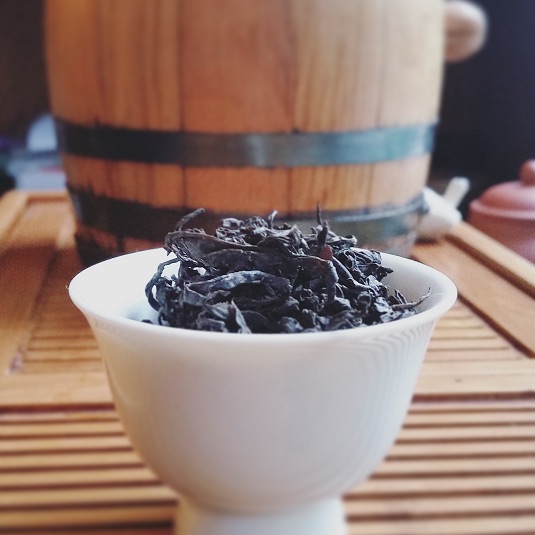
I acquired a miniature bourbon barrel in 2014, and—since then—I’d taken teas I liked and subjected them to bourbon scenting. Sometimes the results were wonderful. Other times . . . the less spoken about them, the better. For the most part, I was ready to throw in the towel on the entire process. Yet some part of me felt like Doke Black Fusion could take it and dish it.
In March, I was blessed with an opportunity to do so. Vivek Lochan got in touch with me about doing a blog for their Doke Tea website. I pitched to him what I wanted to do with Black Fusion, and I could practically see his eyes widen through the computer screen.
A couple of weeks after that, a package arrived. I had my Black Fusion—a half a kilo of the stuff. I only needed 200 grams; now, I had double that. Whoah. The next item on the agenda was the alcohol.
Like with a prior puerh experiment, I went with Woodford Reserve. I didn’t drink alcohol anymore, but I knew what Woodford smelled like. It was a perfectly serviceable well bourbon, and the best part? It was inexpensive.
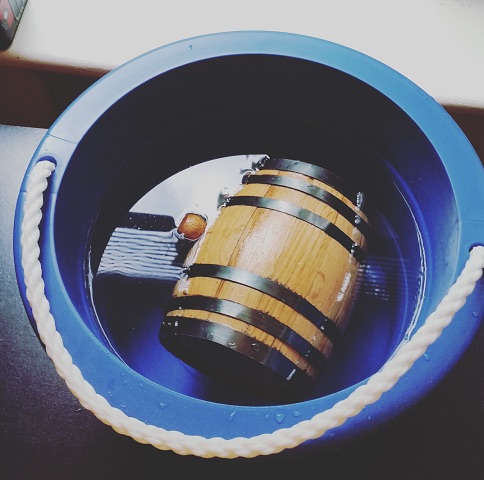 By May, I finally mustered the courage to prep the barrel. The steps were easy but time consuming. First, I had to soak the barrel in water for a day to make the oak wood expand. (This was to prevent leakage.)
By May, I finally mustered the courage to prep the barrel. The steps were easy but time consuming. First, I had to soak the barrel in water for a day to make the oak wood expand. (This was to prevent leakage.)
After letting it dry for 24 hours, I added a liter of bourbon.
I didn’t have to fill it to the brim . . . but whatever.
I let the liquor sit in the barrel for seven days. The idea being, the barrel oak would soak up some of the moisture and peaty/gasoline smell from the booze. A week-long duration usually got the job done.
A week went by, and I stopped off at my brother’s house. He assisted me in emptying the liquor from the barrel back into their respective bottles. Then—at long last—the tea leaves went in. 200 grams worth.
In the two years I played with this process, I learned two absolutes. One: Whole leaf black teas loved liquor. And two: Don’t keep said leaves in a micro-barrel for longer than a week. Why? Mold. Or worse.
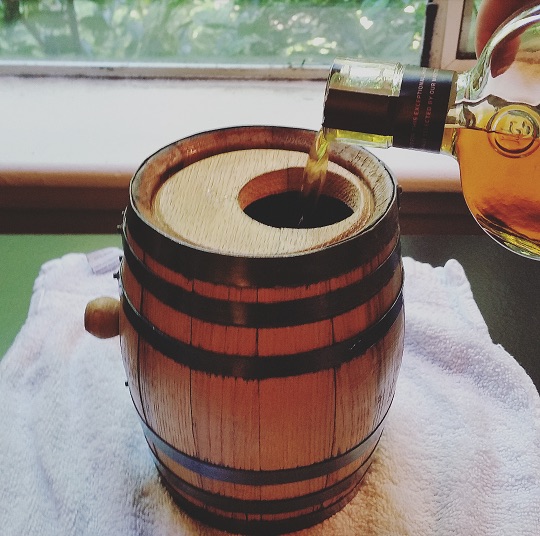 Another week plodded along, and then I was back at my brother’s house. We spread out the leaves on a cooking sheet covered in tinfoil. However, my brother suggested we put them on two cooking sheets to thin out the layer.
Another week plodded along, and then I was back at my brother’s house. We spread out the leaves on a cooking sheet covered in tinfoil. However, my brother suggested we put them on two cooking sheets to thin out the layer.
The reason? It was time to dry the leaves. A standard (and clean) stove put on the lowest temperature (or the equivalent of 250° Fahrenheit) for fifteen minutes. Since the Doke tea leaves were so darned hearty, the drying process took twenty-five minutes.
Then we brewed some up.
When my brother and I initially tasted it, we were struck by how . . . mellow it had become after the process. Black Fusion was usually bursting with notes of honey, nuts and spice—per the Doke terroir. But after the aging, a lot of that had changed; not vanished, per se, just changed. Maybe distilled is a better word?
The malted characteristics were still there, but there was this blanket around them similar to grapes. I even noted (alliteratively) that the aroma and taste were “weirdly wine-grapy”. It wasn’t until the day after, when I had the stuff on my way to work, that I figured it out. I tasted something that reminded me of port wine. It was thick-bodied, dessert-like, pungently sweet, and possessed a slightly “gone off” quality—like port wine. In addition to Black Fusion’s usual, robust profile.
A quick aside: My body seemed to react to the tampering as if it was wine. As in, it went straight to my head, and my tummy gurgled. While I’m completely certain I dried the leaves completely (this time). But I chocked that up to psychosomatics . . . and being a wuss.
I did the dreaded side-by-side test the following day.
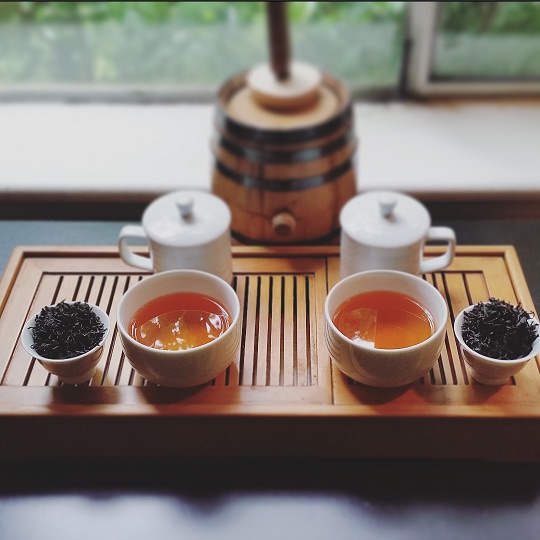 I meant to have the blog on the entire process submitted to Vivek in early June, but then preparations for World Tea Expo got in the way. When I was in Las Vegas for the event, though, I had a moment of inspiration. Rajiv Lochan, the Doke Tea Estate’s owner, was going to be there. Wouldn’t it be neat to get his reaction to the bourbon barrel-aged batch on camera?
I meant to have the blog on the entire process submitted to Vivek in early June, but then preparations for World Tea Expo got in the way. When I was in Las Vegas for the event, though, I had a moment of inspiration. Rajiv Lochan, the Doke Tea Estate’s owner, was going to be there. Wouldn’t it be neat to get his reaction to the bourbon barrel-aged batch on camera?
And with Rachel “I Heart Teas” Carter’s help, I did.
I gifted him a bag, and I also passed the rest to other tea friends. Did I need any for myself? No. That wasn’t why I did it. Frankly, since I stopped drinking bourbon, I no longer favored bourbon flavor. I didn’t think the process was an improvement on the regular Black Fusion, only something different. I wasn’t even sure the process was successful.
In the following weeks, though, Rajiv informed me that he tried it . . . and shared it with some of his tea compatriots in China. They all said it had “lemon notes”. That was weird.
Friend Naomi “Joy’s Teaspoon” Rosen also mentioned on social media that she tried it. With a strawberry breakfast.
And she enjoyed it.
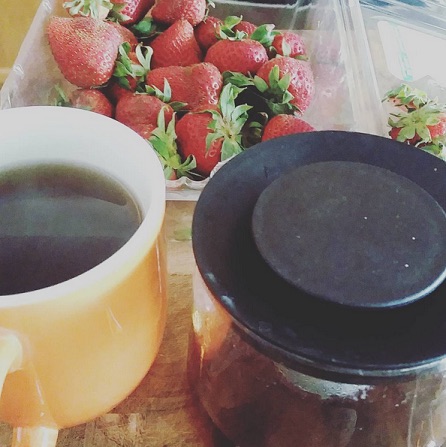 In the end, I suppose that’s why I did it. To see others enjoy it. I suppose that’s why Doke makes it, too.
In the end, I suppose that’s why I did it. To see others enjoy it. I suppose that’s why Doke makes it, too.
